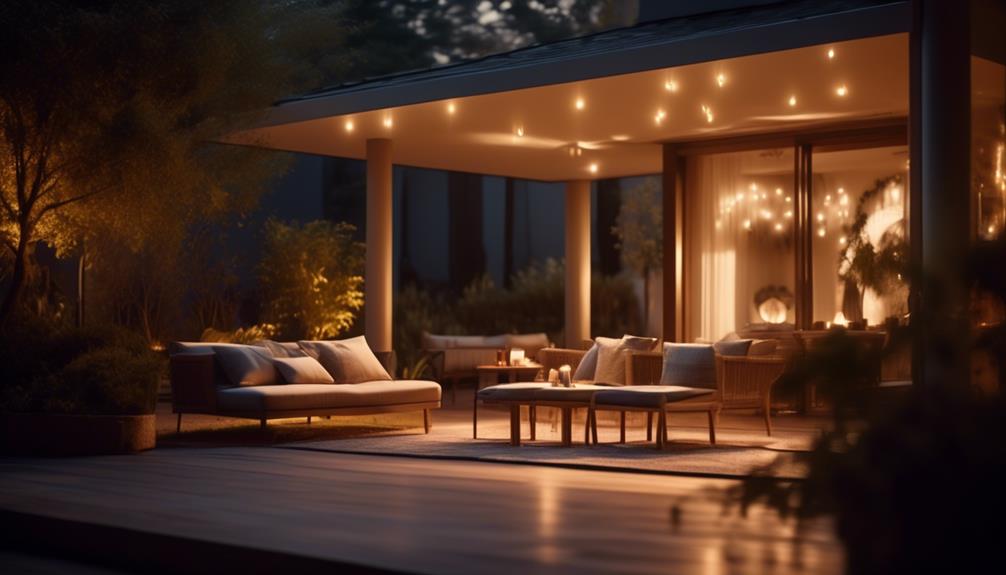As we step into the realm of architectural lighting design, we find ourselves navigating a sea of possibilities, like a captain charting a course through uncharted waters. In this vast ocean of ideas and techniques, it is crucial to identify the top three best practices that will not only illuminate spaces efficiently but also enhance the overall aesthetic appeal.
So, what are these practices that can elevate architectural spaces to new heights?
Let us embark on this illuminating journey together, as we shed light on:
- The proper illumination levels
- Strategic placement of light fixtures
- The seamless integration of natural and artificial light sources.
Key Takeaways
- Proper illumination levels enhance visual experience and functionality of a space.
- Strategic placement of light fixtures optimizes the visual impact and functionality of a space.
- Integration of natural and artificial light sources creates a harmonious and dynamic lighting environment.
- Incorporating natural light into the design enhances the connection with nature and improves the quality of the indoor environment.
Proper Illumination Levels
We believe that achieving proper illumination levels is crucial in architectural lighting design as it enhances the visual experience and functionality of a space. In order to achieve optimal lighting, it's important to consider lighting controls and automation, as well as energy efficiency in lighting design.
When it comes to lighting controls and automation, the advancements in technology have revolutionized the way we can control and manipulate lighting in a space. From dimmers and timers to motion sensors and smart systems, these tools allow for precise control over the lighting levels, creating the perfect ambiance and enhancing the user experience. Not only do lighting controls and automation provide convenience, but they also contribute to energy efficiency by allowing us to adjust the lighting levels based on occupancy and natural light availability.
Speaking of energy efficiency, it's a key consideration in architectural lighting design. With the increasing focus on sustainability and reducing energy consumption, designers are constantly seeking innovative ways to minimize the energy usage of lighting systems. This includes utilizing energy-efficient light sources, such as LED technology, and implementing lighting strategies that optimize natural light integration.
Strategic Placement of Light Fixtures
Optimizing the visual impact and functionality of a space through architectural lighting design involves strategically placing light fixtures to create the desired atmosphere and highlight key features. The placement of light fixtures is crucial in accentuating the architectural elements and creating a captivating ambiance that evokes emotions and enhances the overall experience.
One of the most effective accent lighting techniques is the use of directional fixtures. These fixtures, such as track lights or adjustable recessed lights, allow for precise control over the beam angle and direction of light. By strategically positioning these fixtures, designers can draw attention to specific areas or objects, creating focal points that command attention and add drama to the space.
To further enhance the strategic placement of light fixtures, lighting control systems play a vital role. These systems allow designers to adjust the intensity, color, and direction of light, providing endless possibilities for creating different moods and atmospheres. With the use of smart controls and automation, lighting can be programmed to change throughout the day, adapting to the natural lighting conditions and enhancing the space's functionality.
What Are the Key Best Practices in Architectural Lighting Design?
When it comes to creating impactful spaces, understanding architectural lighting design principles is crucial. Key best practices in architectural lighting design involve understanding the specific functionality and aesthetic goals of the space, utilizing a variety of lighting techniques to enhance the architecture, and prioritizing energy efficiency and sustainability.
Integration of Natural and Artificial Light Sources
By seamlessly integrating natural and artificial light sources, architects and lighting designers can create a harmonious and dynamic lighting environment that enhances the aesthetics and functionality of a space. This integration is achieved through the use of passive daylighting techniques and a balanced lighting design.
Here are four ways in which the integration of natural and artificial light sources can evoke an emotional response in the audience:
- Enhanced Connection with Nature: By incorporating natural light into the design, the space becomes more inviting and soothing. The interplay between natural and artificial light creates a sense of harmony, bringing the outdoors inside and making occupants feel connected to nature.
- Visual Interest and Drama: The strategic use of natural and artificial light sources can create dramatic lighting effects, adding depth and dimension to the space. This dynamic lighting design captivates the audience and evokes a sense of wonder and intrigue.
- Energy Efficiency and Sustainability: Passive daylighting techniques reduce the reliance on artificial lighting, resulting in energy savings and a reduced carbon footprint. This integration not only benefits the environment but also showcases the innovative and sustainable approach of the design.
- Flexible and Adaptive Spaces: Integrating natural and artificial light sources allows for greater flexibility in space utilization. The lighting design can be adjusted to meet the changing needs of the occupants, creating versatile spaces that cater to different activities and moods.
